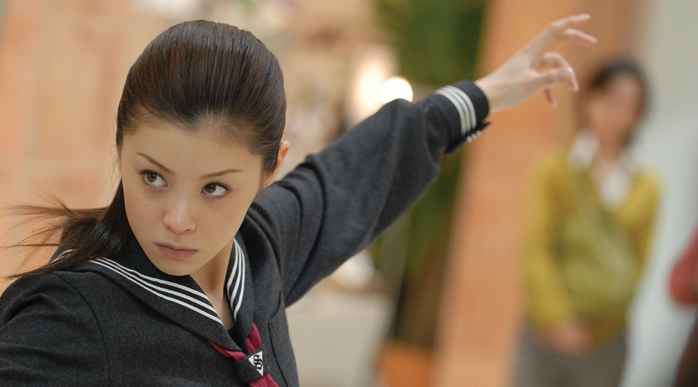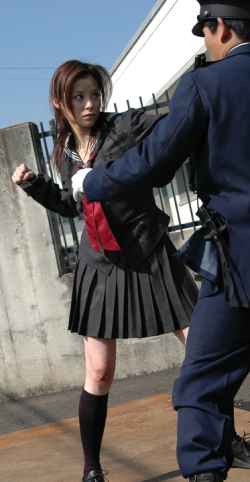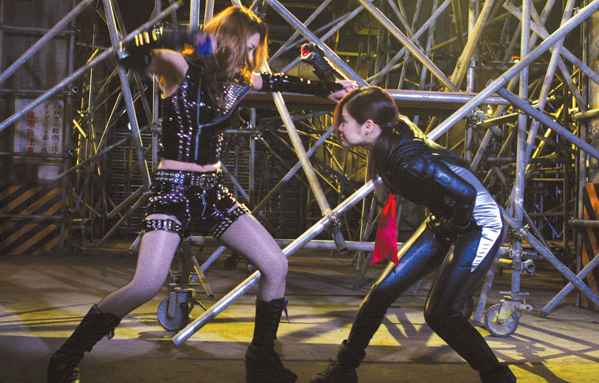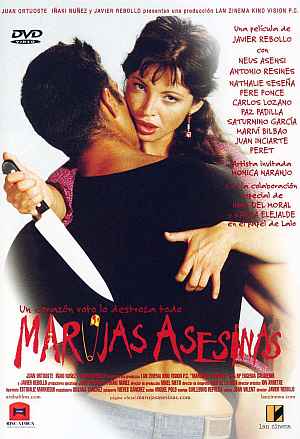
“The String Cheese Incident”
 Rarely has the phrase, “Only in Japan,” ever been more appropriate. It’s not just the notion of a delinquent schoolgirl, taken in by the government and turned into a secret-agent of sorts. That, alone, is odd, but not particularly memorable. No, it’s that her weapon of choice is a yo-yo, which lifts this into the realm of the call-sign, Whiskey Tango Foxtrot. [Contrary to popular belief, the toy was not inspired by a Phillipino weapon, as has often been claimed – the yo-yo appears on Greek vases dating from well before the birth of Christ. Never say this site is not educational.] Combine that fairly ridiculous aspect with an absolutely straight-faced approach to the subject matter, and you’ve got something which has definite potential to be a trash classic, and was obviously the inspiration for GoGo Yubari in Kill Bill.
Rarely has the phrase, “Only in Japan,” ever been more appropriate. It’s not just the notion of a delinquent schoolgirl, taken in by the government and turned into a secret-agent of sorts. That, alone, is odd, but not particularly memorable. No, it’s that her weapon of choice is a yo-yo, which lifts this into the realm of the call-sign, Whiskey Tango Foxtrot. [Contrary to popular belief, the toy was not inspired by a Phillipino weapon, as has often been claimed – the yo-yo appears on Greek vases dating from well before the birth of Christ. Never say this site is not educational.] Combine that fairly ridiculous aspect with an absolutely straight-faced approach to the subject matter, and you’ve got something which has definite potential to be a trash classic, and was obviously the inspiration for GoGo Yubari in Kill Bill.
The title, Sukeban Deka, roughly translates as “Delinquent girl detective”, and was created by manga author Shinji Wada, running in 22 volumes from January 1976 through to December 1982. It was, to some extent, a fortuitous accident: the publisher was expecting a detective tale, Wada was working on a high-school story, and the two concepts ended up getting welded together. The heroine is more or less the same in all incarnations: Saki Asamiya, the trouble-making schoolgirl who ends up in prison, and eventually becomes an undercover spy for the government, though in the manga, it seems this only takes place after a fair amount of babes-behind-bars shenanigans. For the purposes of this piece, I’ll largely be glossing over both the manga and the TV show, and concentrating on the three feature films. The first two of these were spin-offs from the TV series, and appeared in 1987 and 1988, while the third reached cinemas almost twenty years later.
However, let’s start with some discussion of the TV series, albeit only because I somehow ended up with three episodes of the second series on laserdisc, about fifteen years ago. This ran for 108 half-hour episodes over three series between April 1985 and October 1987, which starred Yuki Saito, Yoko Minamino and Yui Asaka respectively. These appear to be different characters, albeit with the same name, suggesting that “sukeban deka” is a label perhaps more akin to the “Double-0” tag, with Saki Asamiya being the equivalent of James Bond. There was apparently also a TV movie, with the catchy title of Sukeban Deka III: shôjo ninpô-chô denki: san-shimai mottomo kiken na tabi: yattsu no shi no wana, which was screened in April 1987.
 This appears to be episodes 34-36 of the second series, and having watched them, I feel I can convincingly state, with little fear of contradiction, that I have little or no idea what is going on. #34 takes place mostly in the woods, with Saki apparently possessed by something that causes her to attack her friends. Also roaming the woods is a samurai, and another schoolgirl, who possesses fangs, and leaps to the attack accompanied by cat noises. There is a fair amount of largely-unconvincing fighting, ending when Saki has her memory jogged by a small trinket, apparently breaking the curse placed upon her. To say any more would probably be…unwise.
This appears to be episodes 34-36 of the second series, and having watched them, I feel I can convincingly state, with little fear of contradiction, that I have little or no idea what is going on. #34 takes place mostly in the woods, with Saki apparently possessed by something that causes her to attack her friends. Also roaming the woods is a samurai, and another schoolgirl, who possesses fangs, and leaps to the attack accompanied by cat noises. There is a fair amount of largely-unconvincing fighting, ending when Saki has her memory jogged by a small trinket, apparently breaking the curse placed upon her. To say any more would probably be…unwise.
It is, however, a masterpiece of comprehensibility compared to parts #35 and #36, though I was distracted by the arrival of a family friend, and so I must admit, my attention was largely diverted. If I had to hazard a guess – and you would probably need to use pliers and a blowtorch to get this out of me – it appears to be something to do with an after-school justice club, whose activities somehow land Saki in jail by the end of the episode. There is also a metal mask of some sort, whose eyes occasionally glow red. Please note, I am simply reporting these things.
The final episode has Saki’s two friends wondering what happened to her, while Saki sits in jail and stares at the metal mask on her bed. This does not exactly make for enthralling television, in any language, but things do perk up towards the end. There’s a roof-top battle in which Saki wears the mask and, along with her two colleagues, fights the bad guys until one of them shoots hooks from his sleeves, which attach to the mask and rip if off her head, to the ground below where someone then runs off with it. I imagine it probably has some kind of power, but what it is, I’ll probably never know.
[Below, you’ll find links to further reviews, covering the first series, both the contemporary feature films, and the 2006 revival. Thankfully, these did at least come with subtitles.]






 “Yo-yo. Girl. Cop,” said Chris, burdening those three words with sarcasm, as only she can, and giving me one of those sidelong glances, heavy with additional meaning. Hey, what can I say. This was an unexpected revival of the series, from 2006, with the lead played by pop singer Matsura. She is a wild-child coerced into undercover work by Kazutoshi Kira (Takeuchi, from Takashi Miike’s Dead or Alive trilogy), to save her mother who is being held on espionage charges in the US [in a nice touch, Mom is played by Yuki Saito, who was the first live-action Sukeban Deka, in the original TV series]. Her mission – should she choose to accept it – is to go into a high-school and uncover those behind the threatening Enola Gay website, a neo-terrorist URL that now has a counter on it, with less than 72 hours remaining. She befriends Konno Tae (Okada), the meek victim of relentless bullying, and also encounters the school’s queen bee, Reika Akiyama (Rika Ishikawa – shown right, and another pop singer, like Okada part of the v-u-den group) and her clique. Can she work out what’s going down, and pull the plug on it?
“Yo-yo. Girl. Cop,” said Chris, burdening those three words with sarcasm, as only she can, and giving me one of those sidelong glances, heavy with additional meaning. Hey, what can I say. This was an unexpected revival of the series, from 2006, with the lead played by pop singer Matsura. She is a wild-child coerced into undercover work by Kazutoshi Kira (Takeuchi, from Takashi Miike’s Dead or Alive trilogy), to save her mother who is being held on espionage charges in the US [in a nice touch, Mom is played by Yuki Saito, who was the first live-action Sukeban Deka, in the original TV series]. Her mission – should she choose to accept it – is to go into a high-school and uncover those behind the threatening Enola Gay website, a neo-terrorist URL that now has a counter on it, with less than 72 hours remaining. She befriends Konno Tae (Okada), the meek victim of relentless bullying, and also encounters the school’s queen bee, Reika Akiyama (Rika Ishikawa – shown right, and another pop singer, like Okada part of the v-u-den group) and her clique. Can she work out what’s going down, and pull the plug on it?
 Perhaps the most startling thing here is the amount of political subtext, albeit likely somewhat unintentional. Saki Asamiya (Asaka) is part of the student police force, but feels they are overly brutal, beating anyone who “isn’t a straight arrow”, to quote Asamiya. This leads her to quit, heading off for a spot of slow-motion horse-riding more befitting a feminine hygiene commercial. However, she returns, teaming up with her sisters, when she discovers that her erstwhile colleagues are staging terrorist attacks, and blaming them on a group called the Outcast League, a with the aim of strengthening their position and gaining even greater powers. Asamiya joins the League, only to find the full force of the law now turned on her.
Perhaps the most startling thing here is the amount of political subtext, albeit likely somewhat unintentional. Saki Asamiya (Asaka) is part of the student police force, but feels they are overly brutal, beating anyone who “isn’t a straight arrow”, to quote Asamiya. This leads her to quit, heading off for a spot of slow-motion horse-riding more befitting a feminine hygiene commercial. However, she returns, teaming up with her sisters, when she discovers that her erstwhile colleagues are staging terrorist attacks, and blaming them on a group called the Outcast League, a with the aim of strengthening their position and gaining even greater powers. Asamiya joins the League, only to find the full force of the law now turned on her. This film was made between season two and season three of the television series, and represents a passing of the torch from Saki, SD #2 (Minamino) to SD #3 (Asaka), in preparation for the upcoming TV show. Saki has just about given up her life as a detective, but finds herself dragged in when she, literally, bumps into someone on the street. He turns out to be an escapee from Hell Castle, a reform school for wayward kids on an island near Tokyo, and she discovers that Principal Hattori (Ibu) is training the pupils to be a brainwashed army for an upcoming coup d’etat [the word is exactly the same in Japanese, incidentally]. She goes to her bosses with the information, but the investigation is quickly killed from above, for reasons I’m sure you can guess. So, it’s up to Saki to put together a team, sneak onto the island, rescue the inmates and stop Hattori. He turns out to be a nemesis from the TV show, though that back-story will, for obvious reasons, be lost on the vast majority of Western viewers.
This film was made between season two and season three of the television series, and represents a passing of the torch from Saki, SD #2 (Minamino) to SD #3 (Asaka), in preparation for the upcoming TV show. Saki has just about given up her life as a detective, but finds herself dragged in when she, literally, bumps into someone on the street. He turns out to be an escapee from Hell Castle, a reform school for wayward kids on an island near Tokyo, and she discovers that Principal Hattori (Ibu) is training the pupils to be a brainwashed army for an upcoming coup d’etat [the word is exactly the same in Japanese, incidentally]. She goes to her bosses with the information, but the investigation is quickly killed from above, for reasons I’m sure you can guess. So, it’s up to Saki to put together a team, sneak onto the island, rescue the inmates and stop Hattori. He turns out to be a nemesis from the TV show, though that back-story will, for obvious reasons, be lost on the vast majority of Western viewers.
 Rarely has the phrase, “Only in Japan,” ever been more appropriate. It’s not just the notion of a delinquent schoolgirl, taken in by the government and turned into a secret-agent of sorts. That, alone, is odd, but not particularly memorable. No, it’s that her weapon of choice is a
Rarely has the phrase, “Only in Japan,” ever been more appropriate. It’s not just the notion of a delinquent schoolgirl, taken in by the government and turned into a secret-agent of sorts. That, alone, is odd, but not particularly memorable. No, it’s that her weapon of choice is a  This appears to be episodes 34-36 of the second series, and having watched them, I feel I can convincingly state, with little fear of contradiction, that I have little or no idea what is going on. #34 takes place mostly in the woods, with Saki apparently possessed by something that causes her to attack her friends. Also roaming the woods is a samurai, and another schoolgirl, who possesses fangs, and leaps to the attack accompanied by cat noises. There is a fair amount of largely-unconvincing fighting, ending when Saki has her memory jogged by a small trinket, apparently breaking the curse placed upon her. To say any more would probably be…unwise.
This appears to be episodes 34-36 of the second series, and having watched them, I feel I can convincingly state, with little fear of contradiction, that I have little or no idea what is going on. #34 takes place mostly in the woods, with Saki apparently possessed by something that causes her to attack her friends. Also roaming the woods is a samurai, and another schoolgirl, who possesses fangs, and leaps to the attack accompanied by cat noises. There is a fair amount of largely-unconvincing fighting, ending when Saki has her memory jogged by a small trinket, apparently breaking the curse placed upon her. To say any more would probably be…unwise. This tale of a Hispanic wife whose sanity disintegrates, beginning with the murder of her husband and ending with…well, you have to see it, had me shifting somewhat nervously, as
This tale of a Hispanic wife whose sanity disintegrates, beginning with the murder of her husband and ending with…well, you have to see it, had me shifting somewhat nervously, as